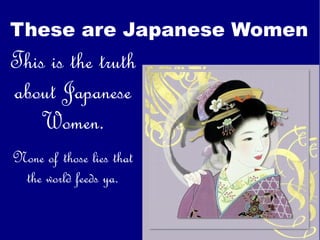
The Love and the Lies of Medieval Japanese Women
- 1. These are Japanese Women This is the truth about Japanese Women. None of those lies that the world feeds ya.
- 2. When you think about Japanese Women, what do you think? I asked several people what their thought were regarding Japanese women, particularly during the Medieval time period. They only wore sandals. They had bound and broken feet. They were completely uneducated. They blackened their teeth cause they were weird. The Geisha were hookers. They had no power at all, especially within the home. They had no say in their marriages. These are the myths that I will be working with, This is what they said:
- 3. The first myth I would like to disprove is the common notion that Japan and China are NOT the same place. Many people assume that since Japan and China are geographically near each other, they are the same culture. This is not so, and as a result of this misconception, confusion can been caused in the differentiation of the two distinct countries. To begin...
- 4. The feet of the japanese woman As was stated on the previous slide, Japan and China are not the same place. Many myths about Japan and its practices have seeped into North American society. One of the most prominent rumors is that of Japanese foot-binding. In China, for many centuries, the practice of foot binding was considered a sign of high class and prestige. On a girls' sixth birthday, her feet would be bound in a painful manner, to force her feet to grow in a deformed manner, making her feet small. However, Japanese women do wear these wooden sandals, called the Geta. These shoes are traditional footwear, and are often worn with Kimonos. They are elevated, and are worn in rain and snow to keep the women's feet elevated. Men also wear this type of footwear, as they are gender neutral footwear.
- 5. Were they educated? In Europe, during the Middle Ages, most women were illiterate and were not formally educated in academic matters. They were merely taught how to attend to domestic chores and tend to their households. It is the common assumption that Japanese women were the same. This is not so, however. Japanese women were giving educational training. They learned how to perform certain daily rituals, including tea ceremonies. They were also taught calligraphic arts. Some were taught how to care for silk worms as well. So unlike their European counterparts, medieval Japanese women were given education. They could read and write, and ha knowledge about certain industries in life.
- 6. How obsessed were they with their appearance? Japanese women, especially in the Middle Ages had a very defined style of beauty. However, this does not make Japanese women shallow, or vain, as some of these beautification methods had a positive impact on them. ' The Japanese practice of Ohaguro, or teeth-blackening was not to scare off enemies, or to show class. Though it initially was a aristocratic practice, teeth blackening was eventually adopted by all Japanese Women. This practice was restricted to married women, and help to set the virgins apart from married women. It also acted an oral sealant, and prevented tooth decay to some degree.
- 7. The Geisha were high class hookers.. The Geisha, a word which is both singular and plural, are a group of traditional Japanese entertainers. A little known fact is that the original Geisha were men, long before women were properly allowed in society. As was previously mentioned, Geisha are essentially entertainers. They were often hired to attend social events and act as ice-breakers, by flirting and mingling with the party guests. They also are skilled musicians, and can sing and dance in a pleasing manner. The Geisha follow a strict set of rules and a firm code of conduct. One of the biggest rules is to not engage in prostitution, that is selling their sex for money. They are merely paid for their excellent company.
- 8. Japanese Women had NO power in their lives. A common notion about Japanese Women, particularly during the Medieval Era, is that they had absolutely no power in their own lives and futures. While it is true that women had little to no choice in their husbands, as their marriages were arranged, that does not mean that their relationship was entirely male dominated. Earlier in Japanese history, following a marriage, a man would move into a woman's household. The woman's house would have assets attached to it, giving the woman quite a bit of freedom and influence over household manners. In fact, during the 12 th century, women had the right to own or inherit property. There were also strict laws forbidden physical abuse, saving many women from potential domestic violence. In addition, they could find employment to bring extra income to the home. In the middle of the Middle Ages, Japanese Women had the most influence and power over their own lives.
- 9. http://www.hyperhistory.net/apwh/essays/comp/c2wommenna.htm http://answers.yourdictionary.com/answers/history/society/what-do-japanese-people-wear.html http://www.wsu.edu:8080/~dee/ANCJAPAN/WOMEN.HTM http://www.suite101.com/content/womens-status-in-japan-a14700 http://www.ginacolliasuzuki.com/author/ohaguro-beautiful-blackened-smiles.html http://people.howstuffworks.com/geisha1.htm http://www.japan-zone.com/culture/geisha.shtml http://www.suite101.com/content/womens-status-in-japan-a14700 http://www.reconstructinghistory.com/japanese/HEIANintro.html In this slide show, I have disproved several common misconceptions about the Japanese women of the past. I know that you will find my information to be accurate, but if you have any doubts, check the references used Slides put together by Paisley Conrad. Pictures searched on Google Images. References looked up on Google. I make an end to my mythbusting action.